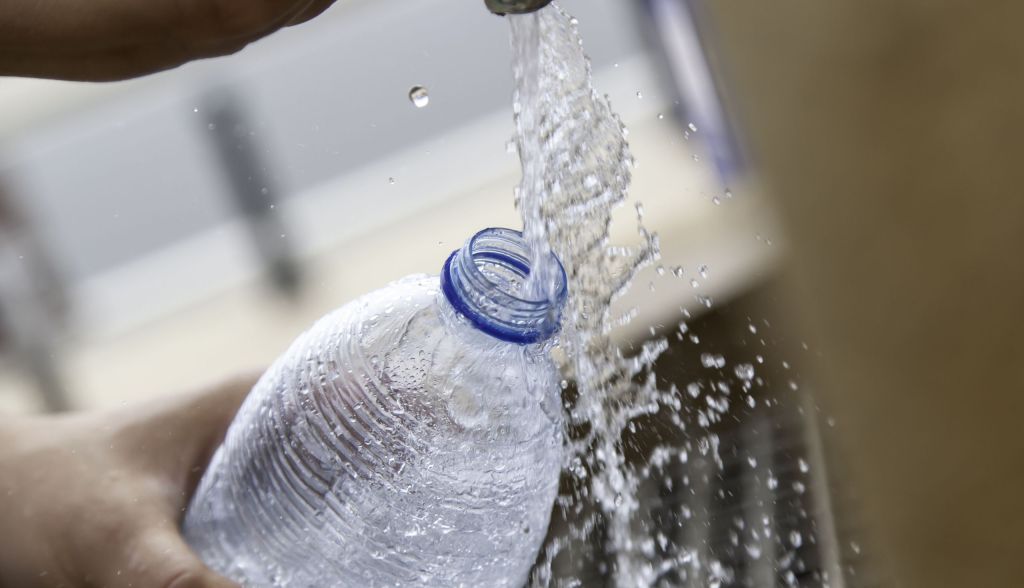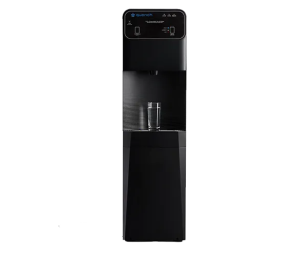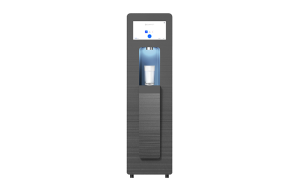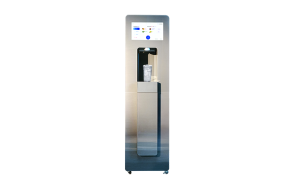
Bottled vs. tap water: What’s safer for your employees?
Businesses often choose between bottled vs. tap water when providing drinking water in the workplace. Municipal water is the most affordable, but more than half of Americans feel it’s not safe to drink, according to an Environmental Working Group (EWG) survey. Bottled water, marketed with images of nature, gives the impression of being cleaner, but it can contain more contaminants than tap water and add to plastic waste on the planet.
Finding the right water solution for your business involves weighing water quality and employee preferences. Your choice can impact water consumption and have a butterfly effect on health, morale and productivity. Below, we’ll explore bottled vs. tap water safety for businesses and discuss the costs, risks and benefits of various options.
Is tap water safe?
The Environmental Protection Agency (EPA) oversees national standards for drinking water in the United States. It sets guidelines for collecting and testing water supplies and limits for over 90 contaminants, including:
- Asbestos
- Arsenic
- Chlorine
- Copper
- Lead
- Perfluoroalkyl and polyfluoroalkyl substances (PFAS)
- Pharmaceuticals
States can set their own drinking water standards, as long as they at least meet the EPA’s requirements. Despite federal and state regulations, many compounds still find their way into tap water. The EWG found 324 contaminants in water across the United States, including heavy metals, radioactive substances and harmful chemicals, such as PFAS, that can be linked to health risks.
“Most municipalities use chlorine or chloramine to make the water safe from a microbiological perspective,” explains Ted Hertz, Culligan’s Vice President of Commercial Drinking Water. “But this does not remove other unwanted impurities like pharmaceuticals, lead, asbestos, arsenic, PFAS/PFOS and microplastics, all of which are very common in tap water.”
Water quality also varies from city to city, and even between buildings:
- The taste, smell and composition of tap water depends on local water sources, which can include lakes, rivers, reservoirs and groundwater.
- Regions may use a variety of treatment methods, such as filtration, reverse osmosis, chlorine, chloramine, UV light and ozone.
- Older pipes, faucets and fixtures can corrode, causing lead, copper, iron and sediment to enter drinking water. Lead pipes are most common in structures built before 1930. Copper pipes with lead solder – often found in buildings constructed before 1980 – may result in both lead and copper leaching into water.
“What people don’t always consider is that water is a solvent and can absorb what it comes in contact with,” Hertz says. “So, if it is sitting in copper or plastic pipes, the water can take on impurities or toxins from those materials.”
Is bottled water safe to drink?
Differences in local water quality may make you wonder if bottled water is safer than tap water. The U.S. Food and Drug Administration (FDA) regulates the safety and labeling of bottled water, recalling products that may pose risks. In recent years, the FDA has recalled brands such as Fiji Water, Berkeley Springs and Topo Chico, a Coca-Cola product.
According to the National Resource Development Council (NRDC), more than 25% of bottled water is tap water, which might not be further treated. While tap water is tested for bacteria at least 100 times a month, bottled water manufacturers are only required to test once a week. The results of municipal water testing are publicly released, while those of bottled water testing aren’t, making it difficult to know what’s in store-bought water.
Although one study found 39% of U.S. adults felt bottled water was a cleaner choice, NRDC tests found more than one in five brands contained chemicals at levels above state guidelines for tap water. An EWG analysis found 38 contaminants in 10 popular brands of bottled water. The toxins included:
- Industrial chemicals
- Pharmaceuticals
- Fertilizer residue
- Bacteria
One of the biggest bottled water safety risks is exposure to chemicals and microplastics. The plastic used to make the containers can leach bisphenols (BPA), phthalates and microplastics into the water, negatively impacting human health. The NRDC cited various studies that found:
- People who drank commercial water consumed more microplastics than those who drank tap water.
- A liter of bottled water can contain about 240,000 particles of micro-nano plastics.
Environmental and cost considerations of bottled vs. tap water
When deciding between bottled vs. tap water, your choice should fit your company’s values, culture and sustainability policies. You may also have budget constraints and want to streamline costs for efficiency.
Bottled water
Aside from plastic bottle water safety concerns, there’s a significant environmental impact to packaged water. According to an article in BMJ Global Health:
- It takes about 17 to 35 liters of water to produce one liter of bottled water.
- The total energy to produce bottled water is 2000 times that of tap water.
- Plastic bottles account for 12% of all plastic waste.
While you can opt for 5-gallon jugs of water instead of individual bottles, commercial water still requires a cooler or dispenser and delivery fee. The total cost depends on how much water you need and how often it’s delivered.
Here’s an estimate of the annual cost of bottled water delivery for 50 people, using our cost comparison calculator:
- Premium bottled water delivery: $7,477
- Bottled water delivery: $4,273
- 5-gallon bottled water delivery: $3,919 (cooler purchase)
- 5-gallon bottled water delivery: $3,422 (cooler rental)
Tap water
Tap water is generally reliable and the most affordable option for businesses. However, 40% of Americans won’t drink it, according to EWG research. Employee perceptions or concerns about water quality can discourage them from consuming water during a shift, which can affect hydration and performance. Alternatively, they may turn to sugary sodas, which offer no nutritional benefit, or spend time leaving work to buy the drinks they prefer.
A better option: Filtered tap water
Let’s table one more option that leverages the benefits of tap water. Filtered water is as convenient and reliable as tap water, but it’s cleaner and better-tasting. It’s also kinder to the planet than bottled water. EWG notes that water filters can reduce common contaminants, such as lead, PFAS, and byproducts of disinfection. Reverse osmosis filters can remove additional contaminants, such as arsenic and perchlorate.
By combining a filtration system with a bottle-free water cooler, you:
- Enhance local water, which federal and state governments tightly regulate
- Screen out contaminants at point of use
- Avoid the microplastics and chemicals from plastic bottles
- Eliminate plastic waste
According to our cost comparison calculator, a filtration system can be more cost-effective than bottled water delivery:
- Bottleless water with filtration system: $1,410 (cooler purchase)
- Bottleless water with filtration system: $542 (cooler rental)
Safer solutions: Filtration and bottleless systems
Filtered water can make sense from a budget perspective, but what do your staff want to drink? If employees aren’t confident or comfortable with the drinking water you provide, they won’t use it, negating any benefits and potentially impacting productivity and performance.
EWG asked 2,800 people what they would do if they were concerned about their tap water quality. The survey found 56% would install a filter, more than the 42% who said they’d reach for bottled water.
Culligan Quench uses an advanced filtration system that removes contaminants from local water to produce cleaner, fresh-tasting water.
The benefits of filtered water include:
- Bottleless water filtration uses your local water supply. You don’t have to arrange water delivery and store or change 5-gallon jugs.
- Water is filtered on-site. Our advanced filtration systems remove additional contaminants from your tap water using technologies such as reverse osmosis, carbon filtration and UV sanitation.
- Bottleless dispensers offer appealing features. Provide your staff and customers with hot and cold water, ice machines and still or sparkling water.
- Filtered water can encourage hydration. In a Culligan Quench study, 85% of respondents said they’d drink more water if they had instant access to cold and hot water at work.
Something as simple as providing high-quality drinking water can also help your employees feel valued and cared for, which Gallup found can translate into higher engagement and satisfaction, lower turnover, and fewer safety incidents. Road Runner Sports switched from water delivery to a bottleless filtration system, resulting in more reliable water for 900 employees nationwide and compliments about the pure-tasting water.
“It’s hard to imagine a workplace not wanting to offer good, clean, great tasting water as a basic perk,” adds Hertz. “And I suspect employees would appreciate that basic benefit.”
So, what’s the right call for your workplace?
There’s more at stake with your company’s water solution than compliance with OSHA standards. Your water choice can influence:
- How much water employees drink
- Their wellness, productivity and satisfaction
- Your company’s progress toward sustainability goals
- Your budget
Local water is affordable and reliable, meeting EPA and state guidelines, but can still contain contaminants. Some people may feel tap water isn’t safe or dislike the taste.
Bottled water gives the impression of being purer than tap water. Although it may be safer because it’s less likely to contain lead from building plumbing systems, it can still contain other contaminants and leach chemicals from the plastic. Plastic bottles also add significantly to your environmental footprint.
Bottleless filtered water systems are a smart way to bridge the gap — removing contaminants, reducing waste and providing a reliable supply of fresh, great-tasting water. Get in touch with Culligan Quench for a free consultation and learn more about how our bottleless water coolers can meet your workplace needs.
Authored by

Elizabeth Smith
Elizabeth Smith is a seasoned writer with a background in science and technology, now focused on workplace wellness, sustainability, and smart business solutions. With more than a decade of experience writing for universities and private companies in the engineering and tech sectors, she brings a research-driven approach to every topic.
Reviewed by

Ted Hertz, Vice President of Commercial Drinking Water Category, Culligan International
Recommended products
Culligan Quench has an advanced suite of point-of-use systems that are designed to meet the needs of workplaces of all shapes and sizes. Here are some products we recommend for your business.
Q12 Touchless Bottleless Water Cooler
Available with quenchWATER+ electrolyte water

Q14 Bottleless Water Cooler
Available with quenchWATER+ electrolyte water
